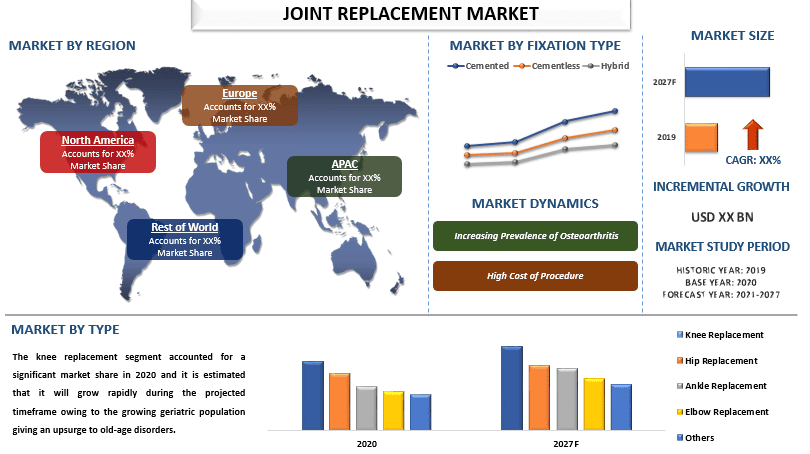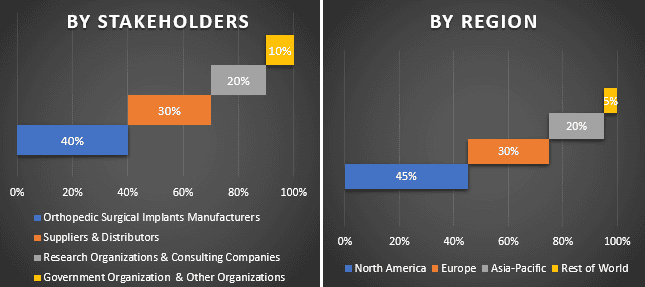- Home
- About Us
- Industry
- Services
- Reading
- Contact Us
Joint Replacement Market: Current Analysis and Forecast (2021-2027)
Emphasis on Type (Knee Replacement, Hip Replacement, Ankle Replacement, Elbow Replacement, Others); Fixation Type (Cemented, Cementless, Hybrid); End-Users (Hospitals, Orthopedic Clinics, Others); Region/Country

Global Joint Replacement Market is anticipated to grow with an elevated CAGR of around 4% over the forecast period (2021-2027). Joint Replacement surgery is an orthopedic surgery performed for replacing the arthritic or dysfunctional joint. The main objective of such procedures is to relieve pain and restore a sense of normal function & mobility in the damaged joints. The joint replacement market is expected to grow owing to the rising prevalence of various orthopedic diseases coupled with a rapidly growing geriatric population. According to the United Nations, the 60+ aged population is expected to double again by 2050 and reach nearly 2.1 billion worldwide. Some of the most common orthopedic diseases among the elderly population are arthritis, lateral epicondylitis, ligament injuries to the knee, etc. Moreover, according to the Centers for Disease Control and Prevention, approximately 29.3% of adults aged 45 to 64 years, reported doctor-diagnosed arthritis, and almost 50% of older people aged 65 years or older, reported doctor-diagnosed arthritis. Owing to these glaring stats, there is a rapid increase in the number of orthopedic surgeries which in turn will significantly impact the growth of the market during the forecast period. The total knee replacement surgeries are projected to grow by 673% to 3.5 million procedures per year by 2030.
Stryker Corporation, Zimmer Biomet Holdings, Inc., Depuy Synthes (Johnson & Johnson), Smith & Nephew, B. Braun Melsungen AG, Wright Medical Group, Corin Group, MicroPort Orthopedics, Exactech, Inc., DJO, LLC, are some of the prominent players operating in the joint replacement market. Several M&As along with partnerships have been undertaken by these players to facilitate customers with joint replacement devices.
Insights Presented in the Report
“Amongst Type, knee replacement segment holds the major share”
Based on the type, the joint replacement market is segmented into knee replacement, hip replacement, ankle replacement, elbow replacement, and others. The knee replacement segment accounted for a significant market share in 2020 and it is estimated that it will grow rapidly during the projected timeframe. The segment is anticipated to grow on account of the growing geriatric population giving an upsurge to old-age disorders such as osteoporosis, arthritis, etc. In the United States, over 600,000 knee replacements are performed every year, as per the Agency for Healthcare Research and Quality.
“Amongst Fixation Type, cemented segment holds the major share”
Based on fixation type, the joint replacement market is divided into cemented, cementless, and hybrid. The cemented segment occupied the major share of the joint replacement market in 2020 and it is expected to grow with a substantial CAGR in the upcoming years. The growth of this segment can be attributed to the rising demand for this type of fixation among older people as cemented fixation has good survivorship and low revision rates in comparison to others.
“Amongst End-Users, hospitals segment holds the major share”
Based on end-users, the market is fragmented into hospitals, orthopedic clinics, and others. In 2020, the hospitals segment grabbed a considerable market share, and it is expected to grow at a significant CAGR during the forecast period. The growth of this segment is attributed to the increasing preference of patients to undergo orthopedic surgical procedures in hospitals owing to the well-established infrastructure, presence of trained healthcare professionals, and advanced devices. However, orthopedic clinics are also likely to witness lucrative growth during the forecast period.
“North America represents one of the largest markets of joint replacement market”
For a better understanding of the market dynamics of the Joint replacement market, a detailed analysis was conducted for different regions across the globe including North America (the U.S, Canada, and the Rest of North America), Europe (Germany, France, Spain, United Kingdom, Italy, and Rest of Europe), Asia-Pacific (China, India, Australia, Japan, and Rest of APAC), Rest of World has been conducted. North America constitutes a major market for the joint replacement market industry in 2020 owing to strong healthcare infrastructure and growing adoption of joint replacement devices in the region.
Reasons to buy this report:
- The study includes market sizing and forecasting analysis validated by authenticated key industry experts
- The report presents a quick review of overall industry performance at one glance
- The report covers an in-depth analysis of prominent industry peers with a primary focus on key business financials, product portfolio, expansion strategies, and recent developments
- Detailed examination of drivers, restraints, key trends, and opportunities prevailing in the industry
- The study comprehensively covers the market across different segments
- Deep dive regional level analysis of the industry
Customization Options:
The global joint replacement market can further be customized as per the requirement or any other market segment. Besides this, UMI understands that you may have your own business needs, hence feel free to connect with us to get a report that completely suits your requirements.
Table of Content
Research Methodology for the Global Joint Replacement Market Analysis (2021-2027)
Analyzing the historical market, estimation of the current market, and forecasting the future market of the global joint replacement market were the three major steps undertaken to create and analyze the adoption of joint replacement in major regions globally. Exhaustive secondary research was conducted to collect the historical market numbers and estimate the current market size. Secondly, to validate these insights, numerous findings and assumptions were taken into consideration. Moreover, exhaustive primary interviews were also conducted, with industry experts across the value chain of the global joint replacement market. Post assumption and validation of market numbers through primary interviews, we employed a top-down/bottom-up approach to forecasting the complete market size. Thereafter, market breakdown and data triangulation methods were adopted to estimate and analyze the market size of segments and sub-segments of the industry pertains to. Detailed methodology is explained below:
Analysis of Historical Market Size
Step 1: In-Depth Study of Secondary Sources:
Detail secondary study was conducted to obtain the historical market size of joint replacement through company internal sources such as annual reports & financial statements, performance presentations, press releases, etc., and external sources including journals, news & articles, government publications, competitor publications, sector reports, third-party database, and other credible publications.
Step 2: Market Segmentation:
After obtaining the historical market size of the joint replacement market, we conducted a detailed secondary analysis to gather historical market insights and share for different segments & sub-segments for major regions. Major segments included in the report as type, fixation type, and end-users. Further country-level analyses were conducted to evaluate the overall adoption of Joint replacement across the globe.
Step 3: Factor Analysis:
After acquiring the historical market size of different segments and sub-segments, we conducted a detailed factor analysis to estimate the current market size of the joint replacement. Further, we conducted factor analysis using dependent and independent variables such as type, application, and end-users. A thorough analysis was conducted for demand and supply-side scenarios considering top partnerships, mergers and acquisition, business expansion, and product launches in the Joint replacement sector across the globe.
Current Market Size Estimate & Forecast
Current Market Sizing: Based on actionable insights from the above 3 steps, we arrived at the current market size, key players in the joint replacement market, and market shares of the segments. All the required percentage shares split, and market breakdowns were determined using the above-mentioned secondary approach and were verified through primary interviews.
Estimation & Forecasting: For market estimation and forecast, weights were assigned to different factors including drivers & trends, restraints, and opportunities available for the stakeholders. After analyzing these factors, relevant forecasting techniques i.e., the top-down/bottom-up approach were applied to arrive at the market forecast for 2027 for different segments and subsegments across the major markets globally. The research methodology adopted to estimate the market size encompasses:
- The industry’s market size, in terms of value (US$) and the adoption rate of joint replacement across the major markets domestically
- All percentage shares, splits, and breakdowns of market segments and sub-segments
- Key players in the joint replacement market in terms of products offered. Also, the growth strategies adopted by these players to compete in the fast-growing market
Market Size and Share Validation
Primary Research: In-depth interviews were conducted with the Key Opinion Leaders (KOLs) including Top Level Executives (CXO/VPs, Sales Head, Marketing Head, Operational Head, and Regional Head, Country Head, etc.) across major regions. Primary research findings were then summarized, and statistical analysis was performed to prove the stated hypothesis. Inputs from primary research were consolidated with secondary findings, hence turning information into actionable insights.
Split of Primary Participants in Different Regions

Market Engineering
The data triangulation technique was employed to complete the overall market estimation and to arrive at precise statistical numbers for each segment and sub-segment of the joint replacement market. Data was split into several segments & sub-segments post studying various parameters and trends in the areas of type, application, and end-users of the joint replacement market.
The main objective of the Joint replacement Market Study
The current & future market trends for joint replacement were pinpointed in the study. Investors can gain strategic insights to base their discretion for investments on the qualitative and quantitative analysis performed in the study. Current and future market trends determined the overall attractiveness of the market at a regional level, providing a platform for the industrial participant to exploit the untapped market to benefit from a first-mover advantage. Other quantitative goals of the studies include:
- Analyze the current and forecast market size of joint replacement in terms of value (US$). Also, analyze the current and forecast market size of different segments and sub-segments
- Segments in the study include areas of type, fixation type, and end-users
- Define and analysis of the regulatory framework for the joint replacement industry
- Analyze the value chain involved with the presence of various intermediaries, along with analyzing customer and competitor behaviors of the industry
- Analyze the current and forecast market size of the joint replacement market for the major region
- Major regions studied in the report include North America, Europe, Asia-Pacific, and Rest of the world
- Company profiles of the joint replacement market and the growth strategies adopted by the market players to sustain in the fast-growing market
- Deep dive regional level analysis of the industry
Related Reports
Customers who bought this item also bought










